Mercury Statistics By Planetary Data, Atmosphere, Structure And Facts (2025)

Updated · Dec 03, 2025


WHAT WE HAVE ON THIS PAGE
- Introduction
- Editor’s Choice
- Facts About Mercury
- Planetary Data of Mercury
- Internal Structure and Surface of Mercury
- Orbits And Rotations, and Formation of Mercury
- Mercury’s Magnetic Field Insight
- Mercury and Earth Comparison
- The Atmosphere of Mercury Statistics
- Mercury Travel Time Statistics
- Mariner 10 Statistics
- Conclusion
Introduction
Mercury Statistics: Mercury is the innermost planet from the Sun and the smallest planet in the Solar System. Mercury is an extreme planet. One day, i.e., nearly 30 Earth days, it is one of the unbearably hot spots of the Solar system, which is four times hotter than boiling water. By night, the temperature crashes thousands of degrees below freezing.
This is because the poor gravity cannot keep a clutch in a heat-trapping environment. Despite the grating atmosphere, this hot and cool rock gives peaks for the astronauts. Despite the harsh atmosphere, this hot and cold stone gives perks to the astronauts. A frail magnetic field safeguards the visitors from the Sun’s dangerous solar radiation, and the crater-pocked surface may contain many valuable minerals.
Let’s shed more light on the Mercury Statistics through this article.
Editor’s Choice
- Mercury is the smallest planet in our solar system and has a magnetic field generated by its liquid core through a dynamo effect, similar to Earth’s.
- Mercury orbits the Sun every 88 days, moving at a speed of about 47 kilometers per second (29 miles per second), which is faster than any other planet.
- Mariner 10 was the first spacecraft to visit Mercury and the first to explore both Venus and Mercury closely in one mission.
- Mariner 10 used gravity assist to change its flight path and was the first mission to return to its original target after flybys.
- Mariner 10 captured images of Mercury’s southern polar region on its second flyby on September 21, 1974, from a distance of 29,869 miles (48,069 kilometers).
- Mariner 10 took 147 days to reach Mercury after its launch.
- Mercury’s median orbital speed is 47.87 kilometers per second as it revolves around the Sun.
- Mercury’s surface temperatures range from 800 degrees Fahrenheit during the day to -290 degrees Fahrenheit at night.
- The Messenger spacecraft identified ions of oxygen, sodium, magnesium, potassium, calcium, and sulfur during its 2008 flyby, caused by solar wind and Mercury’s magnetosphere.
- Helium and hydrogen found near the surface mostly originate from the solar wind, but they escape within hours due to Mercury’s weak gravity.
- The Messenger spacecraft found no significant magnetic variations in Mercury’s crust, suggesting that its magnetic field is actively generated, not a leftover from the past.
- Mercury’s rotation and orbit are so unique that a full day (sunrise to sunrise) lasts longer than its year, and it doesn’t complete one spin between each sunrise and sunset.
- The discovery of polar ice deposits, shielded by an insulating layer, offers potential for future space missions and deeper planetary studies.
Facts About Mercury
- Mercury’s surface is steadily tanking as a result of the innumerable impact events collected over millions of years.
- As per the present models, Mercury may have a hard silicate crust and mantle overlying a hard exterior core, a deeper liquid core layer, and a hard inner crust.
- According to Mercury Statistics, Mercury was created almost 4.5 billion years ago, similar to other planets in the solar system.
- Due to Mercury’s small axial tilt, its poles are permanently in shadow. This vigorously suggests that water ice can be present in the craters.
- One solar day, which means from sunrise to sunset on Mercury, lasts for almost 176 Earth days, which is two times the planet’s sidereal year.
- As per the Earth’s Moon, the surface of Mercury exhibits an extensional rupes system created from shove faults and a bright ray system made by the impact event leftovers.
- Caloris Planitia is the biggest crater, with a diameter of 1,550 km, which is also 1/3rd of the planet’s diameter of 4,880km.
- Mercury is categorized as a tellurian planet with nearly the same surface gravity as Mars.
- Mercury is named after the ancient Roman God “Mercurius,” the God of communication and commerce, and is also known as the Messenger of God.
- With a ratio of 3:2, the sidereal year is 88.0 Earth Days, and the sidereal day is 58.65 Earth Days on Mercury. This connection is known as a spin-orbit barrage, and the sidereal is meant as “relative to the stars.”
- In combination with its high orbital tilt, the planet’s exterior experiences varying sunlight temperatures and intensity, with an equal area ranging from -170 degrees Celsius at night to 420 degrees Celsius in the daytime.
- Mercury’s upper surface is a tremendously tenuous exosphere, and a light magnetic area secure enough to deflect solar winds. It does not have a natural satellite.
- Like the Moon, Mercury’s mantle is very homogeneous, which suggests that it had a magma ocean in the past few years.
- According to the present models, Mercury may have a hard silicate crust and mantle overlying a hard exterior core, a deeper liquid core layer, and a hard interior core.
Planetary Data of Mercury
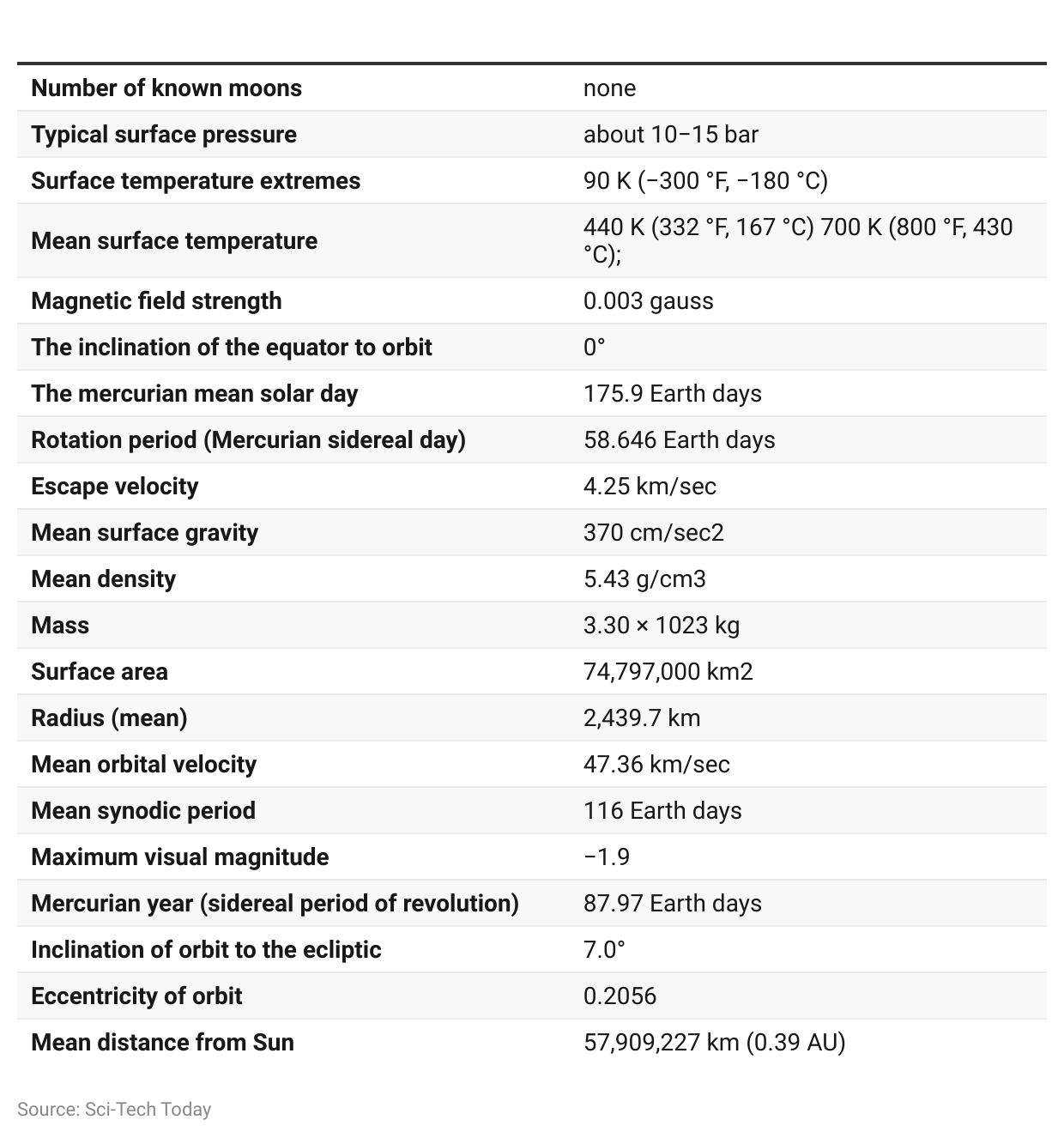
Internal Structure and Surface of Mercury
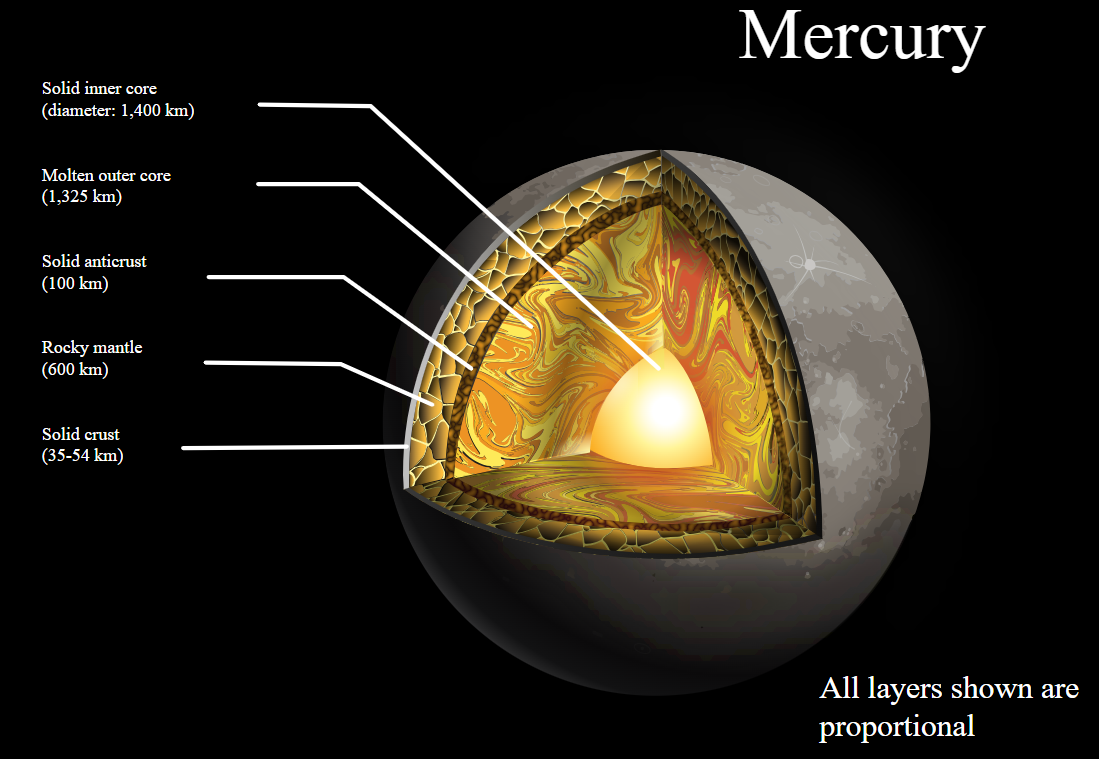
(Source: solarstory.net)
- In our solar system, Mercury is the smallest planet, almost 60% smaller than Earth and just 1404km, which is almost 872.4 miles bigger than our Moon.
- Earth’s density is higher, but because of gravitational condensation, Mercury will be the densest planet.
- Because it is the core at a radius of 1800 to 1900 km, which takes almost 42% of its mass, it has a higher concentration of iron.
- Mercury’s gravitational area is very weak, almost unnoticeable, due to its high iron core and thin crust. Transmission occurs in two ways, so the capacity to make a magnetic field does not exist.
- It also results in less gravity on the surface of Mercury, which will be 26 kg. Mercury’s gravitational pull is much weaker than that of the Earth. This is the outcome of the lack of an environment to safeguard Mercury, so it is spoiled directly.
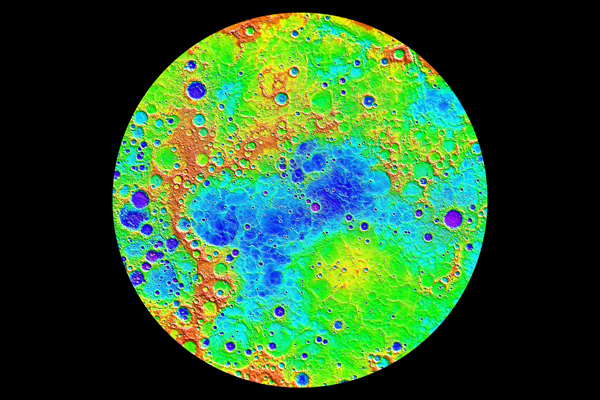
(Source: solarstory.net)
- Mercury is fundamentally a dead planet, which is possible in a short period after it was formed, with no variation in color or the geological features that occur on its surface.
- The surface of Mercury is cluttered with the highest number of impact zones from the meteors, the same as the Moon.
- Mercury generally has a zero environment, which will burn away most of the debris before forming a landfill on the surface. Many of these craters are old enough from the first stages and the next stage of the solar system, which began when Mercury was young.
- When a survey was conducted on Mercury, it was found that in the craters situated at its poles, there is proof of frozen water. This is because Mercury rotates on its axis, which is vertical, keeping its polar region in continuous shadow. With zero environment to retain heat, they stay cold.
- It is thought that the water may have been brought to the planet through a comet that impacted the surface billions of years ago.
- Mercury has an abnormal terrain that may have arrived as a result of a very big impact from a meteor, which is almost 97 km in size and 60 miles in size.
- A 1300 km, or 800 miles, crater known as Caloris Basin states that the effect is the force that sends a shockwave to the opposite side of the planet.
- This is the result caused by the unusually chaotic mixture of hills and fractures on the other side of the affected zone. Not all of Mercury’s craters were formed by meteor effects.
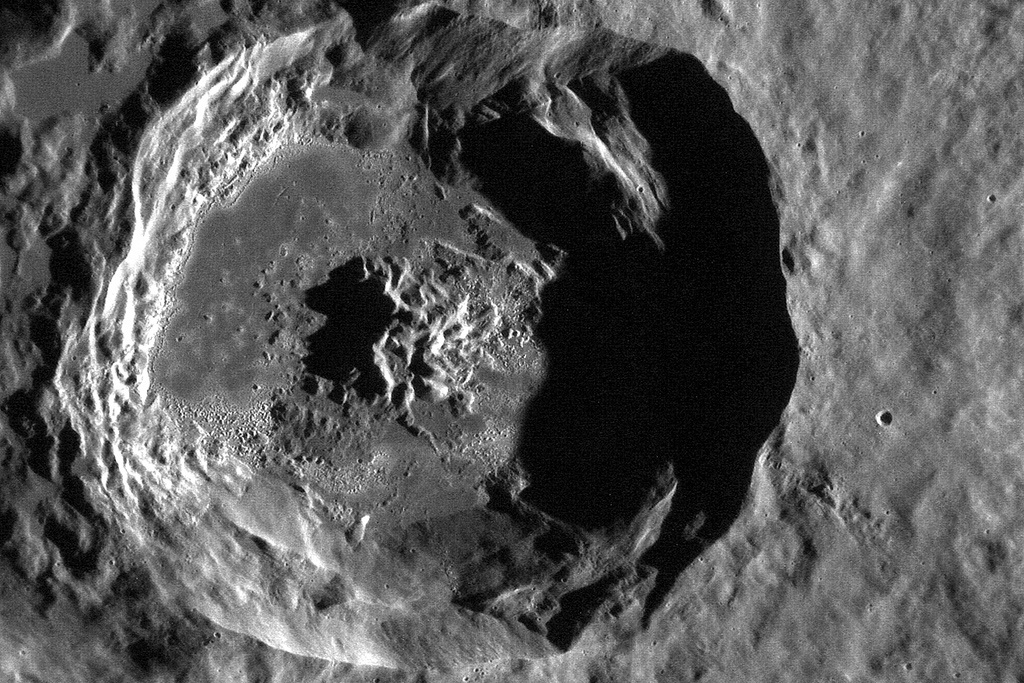
(Source: solarstory.net)
- It is theorized that Mercury’s early stages of development were characterized by volcanoes on its surface. These volcanoes, when they erupted, may have created some of the craters that are seen today.
- Unlike Earth’s volcanoes, those on celestial bodies lacking an atmosphere would behave differently during eruptions.
- Without an atmosphere to contain them, volcanic materials would be expelled into space. Over time, the volcanic “mounds” would be eroded by cosmic winds and impacts from various debris, leaving little trace of their existence on the surface.
Orbits And Rotations, and Formation of Mercury
- According to Mercury Statistics, Mercury rotates very slowly on its axis, completing one rotation every 59 Earth days.
The following are the Mercury Mean orbital elements(J2000):
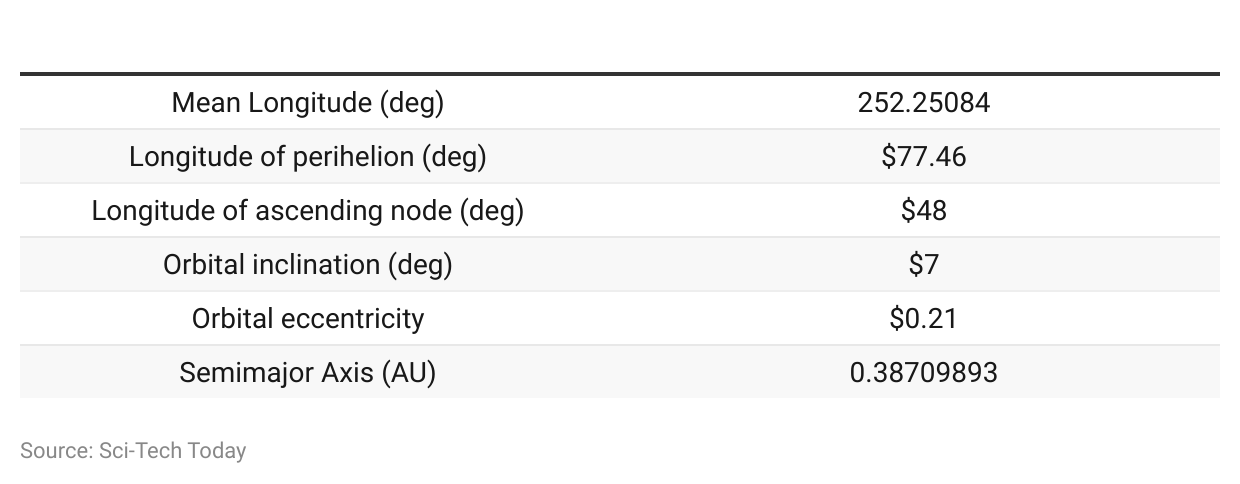
- The egg-shaped and higher-level eccentric orbit takes Mercury as close as 29 million miles, which is similar to 47 million kilometers, and as far as 43 million miles, which is similar to 70 million kilometers, from the Sun.
- Just one Mercury solar day is equivalent to almost 176 Earth days, and it is only more than two years on Mercury.
- When Mercury is rotating fast in its elliptic orbit around the Sun, every round does not complete by sunset and sunrise as it does at its maximum the planets.
- Mercury orbits speeds all over the Sun every 88 days, traveling from space at roughly 29 miles, or 47 kilometers, every second, faster than any other planet.
- Mercury was established about 4.5 billion years ago when the gravitational force pulled the spiral gas and the dust together to make this minute planet near the Sun. Like its companion terrestrial planet, Mercury has a central core, a hard crust, and a rocky mantle.
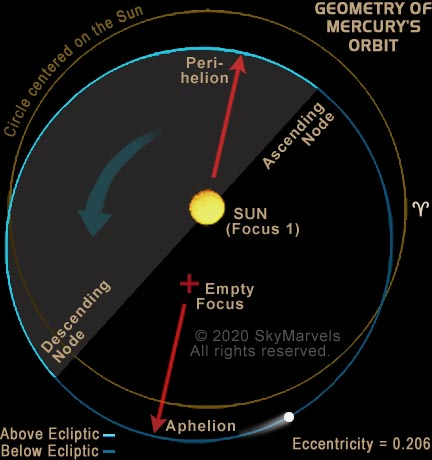
(Source: skymarvels.com)
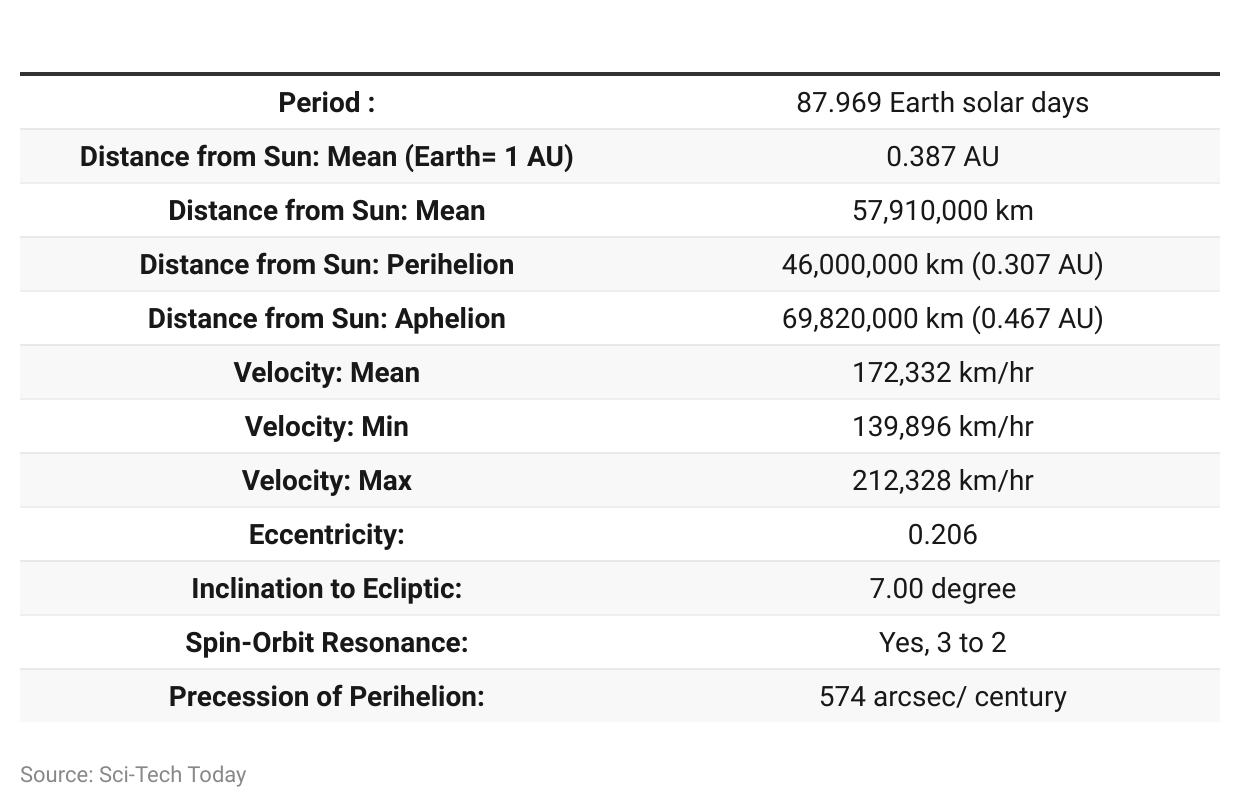
- Mercury’s axis of rotation is only 2 degrees from the plane of its orbit around the Sun. As a result, it spins roughly, very perfectly upright, and doesn’t experience a season like many other planets.
- The Sun in the early morning shows to rise, set, and shortly rise again from many parts of the surface of Mercury. A similar thing is observed backward at sunset for the other parts of the surface.
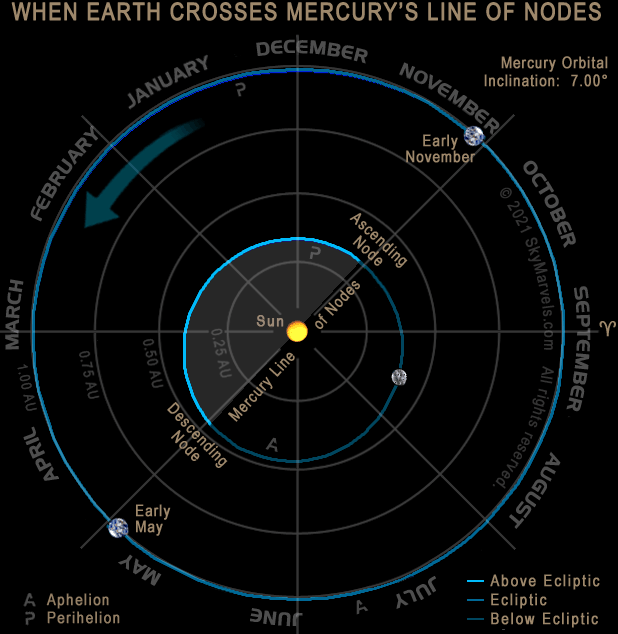
(Source: skymarvels.com)
- In the above chart, we can see the Earth when it crosses Mercury’s line of nodes.
- Mercury’s radius is 1,516 miles (2,440 kilometers), just over one-third as wide as Earth’s. If Earth were the size of a nickel, Mercury would be about the size of a blueberry.
- Mercury’s Average Distance: Mercury orbits the Sun at an average distance of 36 million miles (58 million kilometers), which is equivalent to 0.4 astronomical units (AU). An astronomical unit is the average distance between Earth and the Sun.
- Light Travel Time: At this distance, sunlight takes approximately 3.2 minutes to reach Mercury.
Mercury’s Magnetic Field Insight
- Despite its small size and close distance to the Sun, Mercury’s magnetic field has generated significant interest in the scientific community.
- Understanding this magnetic field not only sheds light on Mercury itself but also offers broader implications for planetary science.
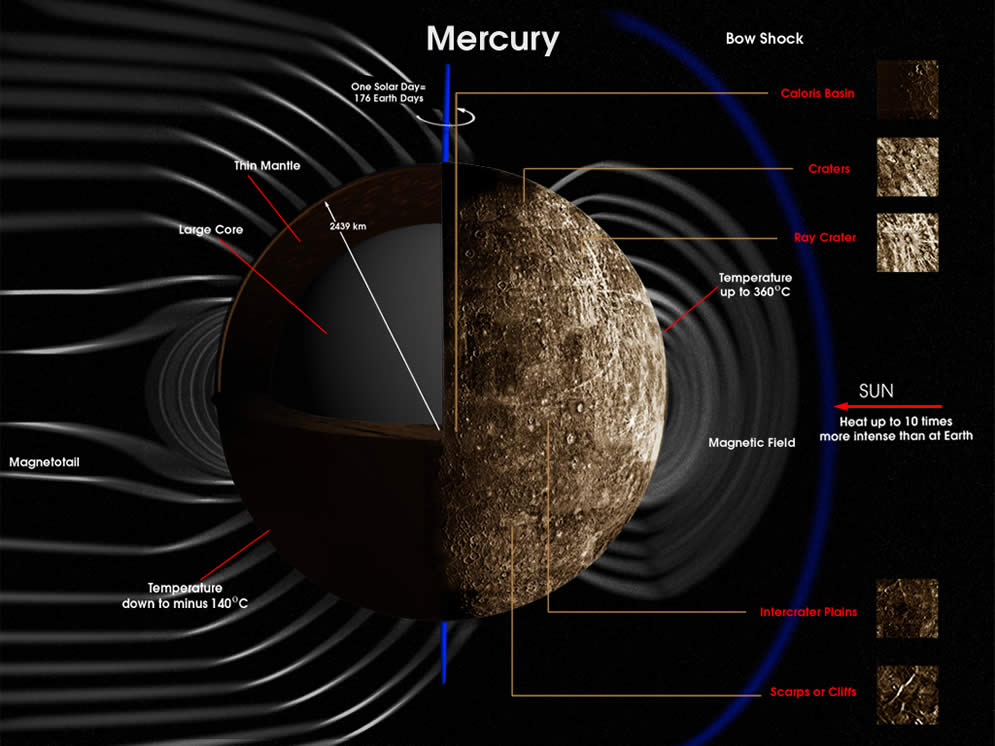
(Source: observatory.astro.utah.edu)
Dynamo Effect: The Core Mechanism
- Generation of Magnetic Fields: Mercury’s magnetic field is created by a process known as the dynamo effect, similar to Earth’s magnetic field generation. This involves the movement of conductive material within the planet’s outer core.
- Core Composition: On Earth, this conductive material consists of molten iron and nickel. Mercury’s core is believed to be at least partially liquid and made of similar metals.
Messenger Spacecraft Discoveries
- Time Variations: The magnetic field on Mercury changes over time, suggesting active internal processes.
- Crust Analysis: The Messenger spacecraft did not detect significant magnetic variations in Mercury’s crust. This indicates that the planet’s magnetic field is not a remnant from an earlier time but rather actively generated by the core.
Magnetic Field Strength
- Comparison to Earth: While Mercury’s magnetic field operates on similar principles as Earth’s, it is about 100 times weaker.
- Influence of the Sun: The Sun’s proximity and the solar wind likely weaken Mercury’s magnetic field. The solar wind, a stream of charged particles from the Sun, can interact with and inhibit the magnetic field.
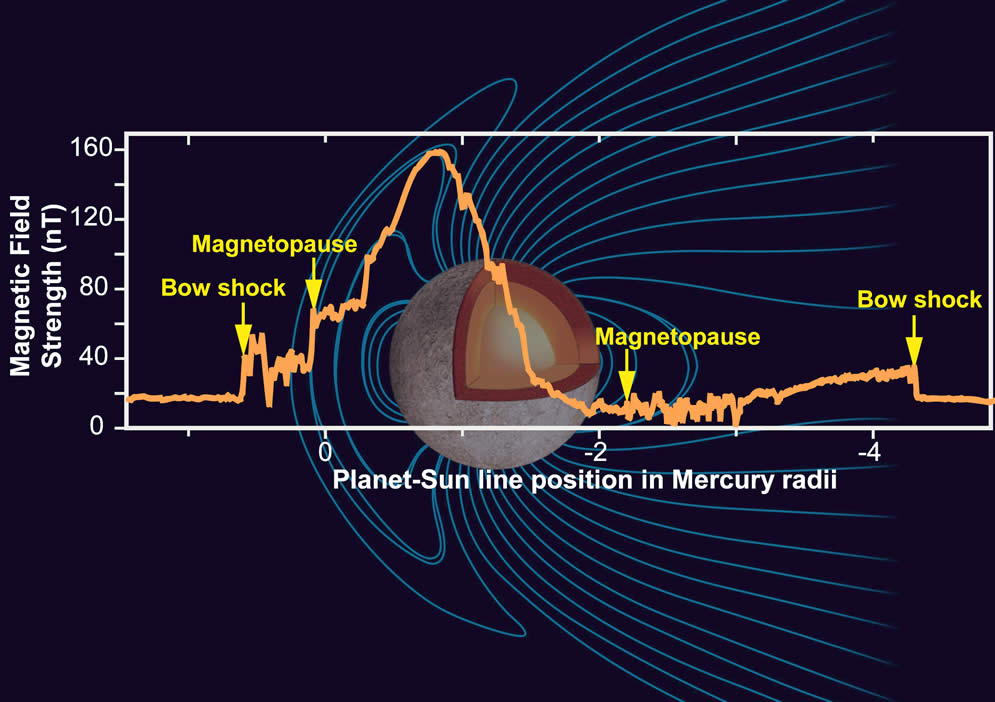
(Source: observatory.astro.utah.edu)
Understanding Mercury’s magnetic field provides insights into:
- Planetary Formation: Studying how Mercury’s magnetic field is generated helps scientists understand the formation and evolution of rocky planets.
- Internal Structure: Data on the magnetic field offers clues about the composition and state of Mercury’s core.
- Mercury, the smallest planet in our solar system, has a magnetic field generated by its liquid core through a dynamo effect similar to Earth’s.
- Despite being 100 times weaker than Earth’s, this magnetic field varies over time, indicating active internal processes.
- The Messenger spacecraft’s findings support the theory of an active core, as there are no significant magnetic traces in the crust.
- The Sun’s solar wind plays a role in weakening Mercury’s magnetic field, offering a unique perspective on how solar interactions affect planetary magnetism.
Mercury and Earth Comparison
-
Bulk Parameters
| Mercury | Earth | Ratio (Earth/ Mercury) |
|
| Planetary Ring system | no | No | – |
| Number of natural satellites | 0 | 1 | – |
| J2 (x 10-6) | 50.3 | 1082.63 | 0.055 |
| Moment of inertia (I/MR square) | 0.35 | 0.3308 | 1.058 |
| Topographic range (km) | 7 | 20 | 0.350 |
| Black- body temperature (K) | 439.6 | 254.0 | 1.731 |
| Solar irradiance( W/m 2) | 9082.7 | 1361.0 | 6.674 |
| V-band magnitude V(1,0) | -0.613 | -3.99 | – |
| Geometric albedo | 0.142 | 0.434 | 0.327 |
| Bond albedo | 0.068 | 0.294 | 0.231 |
| GM (x 106 km3/s2) | 0.022032 | 0.39860 | 0.0553 |
| Escape velocity (km/s) | 4.3 | 11.2 | 0.384 |
| Surface acceleration (pole) (m/s2) | 3.71 | 9.83 | 0.377 |
| Surface acceleration (eq.) (m/s2) | 3.70 | 9.78 | 0.378 |
| Surface gravity (mean) (m/s2) | 3.70 | 9.82 | 0.378 |
| Mean density (kg/m3) | 5429 | 5513 | 0.985 |
| Ellipticity (Flattening) | 0.0009 | 0.00335 | 0.269 |
| Volumetric mean radius (km) | 2439.7 | 6371.0 | 0.383 |
| Polar radius (km) | 2438.3 | 6356.8 | 0.384 |
| Equatorial radius (km) | 2440.5 | 6378.1 | 0.383 |
| Volume (1010 km3) | 6.083 | 108.321 | 0.0562 |
| Mass (1024 kg) | 0.33010 | 5.9722 | 0.0553 |
-
Orbital parameters
| Mercury | Earth | Ratio (Mercury/Earth) | |
| The inclination of the equator (deg) | 0.034 | 23.44 | 0.001 |
| Obliquity to orbit (deg) | 0.034 | 23.44 | 0.001 |
| Length of day (hrs) | 4222.6 | 24.0000 | 175.942 |
| Sidereal rotation period (hrs) | 1407.6 | 23.9345 | 58.785 |
| Orbit eccentricity | 0.2056 | 0.0167 | 12.311 |
| Orbit inclination (deg) | 7.004 | 0.000 | – |
| Min. orbital velocity (km/s) | 38.86 | 29.29 | 1.327 |
| Max. orbital velocity (km/s) | 58.97 | 30.29 | 1.947 |
| Mean orbital velocity (km/s) | 47.36 | 29.78 | 1.590 |
| Synodic period (days) | 115.88 | – | – |
| Aphelion (106 km) | 69.818 | 152.100 | 0.459 |
| Perihelion (106 km) | 46.000 | 147.095 | 0.313 |
| Tropical orbit period (days) | 87.968 | 365.242 | 0.241 |
| Sidereal orbit period (days) | 87.969 | 365.256 | 0.241 |
| Semimajor axis (106 km) | 57.909 | 149.598 | 0.387 |
The Atmosphere of Mercury Statistics
- Mercury, the smallest planet in our solar system, is also one of the hottest. Despite its size and temperature, it has a very thin atmosphere. This atmosphere is so slight that the surface pressure is less than one-trillionth of Earth’s.
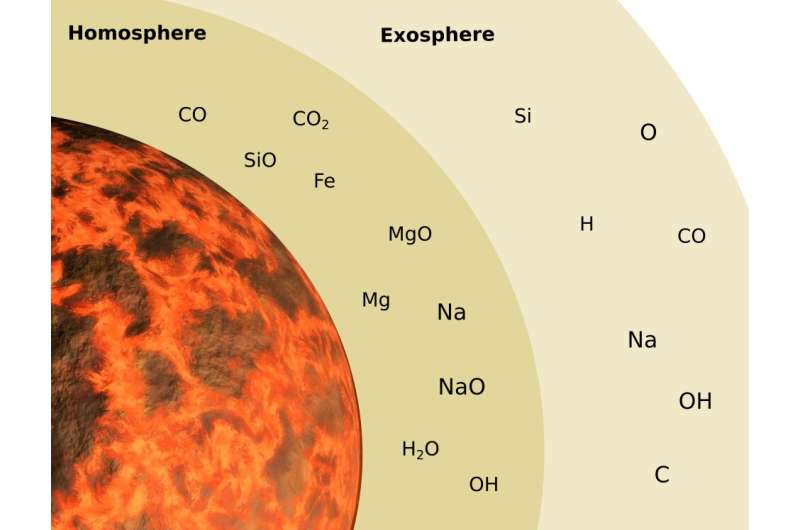
(Source: phys.org)
- In the above chart, we can see the components of the Homosphere and Exosphere.
- Mercury’s atmosphere contains tiny amounts of various elements. Observations from spacecraft like Mariner 10 and Messenger have provided valuable insights:
- Helium and Hydrogen: These elements, found near the surface, mostly come from the solar wind (a stream of charged particles from the Sun). They don’t stay on Mercury for long, escaping within hours.
- Oxygen, Sodium, Potassium, and Calcium: These elements are likely from Mercury’s surface soils or meteoroid impacts. Impacts of the solar wind can eject them into the atmosphere. At night, these gases gather but are dispersed by sunlight in the morning.
- The solar wind and Mercury’s magnetosphere can ionize these atoms, creating ions of oxygen, sodium, magnesium, potassium, calcium, and sulfur. The Messenger spacecraft identified these ions during its 2008 flyby.
- Messenger also discovered Mercury’s long, comet-like tail, which is visible due to sodium emissions.
- Surprisingly, despite being so close to the Sun, Mercury has significant water ice deposits at its poles. This discovery was made using Earth-based radar in the early 1990s and later confirmed by Messenger.
- The ice is found in the permanently shaded floors of craters in the polar regions.
- The water likely came from impacting comets and asteroids over time. Even though Mercury’s surface is very hot, water molecules can hop across the surface and eventually settle in these deep, shadowed craters.
- The ice is insulated by a layer of dark organic material, which protects it from sublimation (turning from ice to vapor). This layer is about 4-8 inches thick and also comes from cometary and asteroidal impacts.
- Understanding Mercury’s atmosphere and ice deposits is about more than just scientific curiosity. It has potential practical applications:
- Resource Utilization: The presence of water ice could be crucial for future missions, providing a potential resource for fuel or life support.
- Planetary Processes: Studying these elements helps scientists understand planetary formation and the impact of the solar wind.
- Mercury’s atmosphere, though incredibly thin, reveals a lot about the planet’s interactions with the solar wind and its surface.
- The discovery of polar ice deposits, protected by an insulating layer, opens up new possibilities for understanding the planet and planning future missions.
Mercury Travel Time Statistics
- The surface temperature of Mercury can rise to almost 800 degrees Fahrenheit, as per Mercury Statistics.
- “MESSENGER” traveled around a distance of 7.9 billion kilometers to transit to Mercury.
- Mercury travels at a median speed of 47.87 km/s in its orbit around the Sun.
- The space between Mercury and the Sun is almost 58 million kilometers.
- Mercury has a total diameter of almost 4,879 kilometers.
- Because Mercury’s environment reflects sunlight, the travel time towards Mercury, as seen by the naked human eye, is instant.
- Mariner 10 performed three flybys of Mercury in 1974 and 1975.
- The BepiColombo will arrive in 2025. It was launched in 2018 and will take more than seven years to reach Mercury.
- The New Horizons spacecraft’s speed is the fastest it has ever launched, but it will still take almost 39 days to travel the median distance to Mercury.
- The very first artificial object to be launched on Mercury was the Mariner 10 in 1974.
- The rotational period of Mercury is almost 59 Earth Days.
- 88 Earth days is the orbital period of Mercury.
- Mercury’s median temperature varies between 800 degrees Fahrenheit during the day and -290 degrees Fahrenheit at night.
- The NASA MESSENGER mission took around seven years to land on Mercury, and it used a trajectory incorporating many gravity assists.
- The Mariner 10 took almost 147 days to land on Mercury after its launch.
- The time it takes to travel towards Mercury is dependent on the alignment of Earth and Mercury and the speed of the spacecraft.
- As a median, the distance between Mercury and Earth is almost 77 million kilometers.
- For light, it takes almost 3.22 minutes to travel from Mercury to Earth.
Mariner 10 Statistics
- Mariner 10 was the first spacecraft sent to Mercury and the first mission to explore Venus and Mercury very closely in a single mission. The first is to return to its basic destination for the other angel, and the first is to use gravity to assist in changing its flight path.
| Nation | United States of America (USA) |
| Launch Site | Cape Canaveral, Fla. / Launch Complex 36B |
| Launch Date and Time | Nov. 3, 1973 / 05:45:00 UT |
| Spacecraft | Mariner-73J / Mariner-J |
| Launch Vehicle | Atlas Centaur (AC-34 / Atlas 3D no. 5014D / Centaur D-1A) |
| Mission Design and Management | NASA / JPL |
| Objective(s) | Mercury Flyby, Venus Flyby |
| Spacecraft Power | Solar |
| Spacecraft Mass | 1,100 pounds (502.9 kilograms) |
| Scientific Instruments |
|
- Mariner 10 was a pioneering spacecraft launched to explore Mercury and Venus. It set several records in space exploration, including being the first to study two planets in one mission, the first to use gravity assist to change its flight path, the first to revisit its target, and the first to use solar wind for orientation.
- Mission Goals: Mariner 10’s primary goal was to study Mercury’s atmosphere (if any), surface, and physical characteristics. The mission also aimed to capture images and gather scientific data on both Mercury and Venus.
Key Achievements:
- First Mission to Explore Two Planets: Mariner 10 was the first spacecraft to explore both Mercury and Venus in a single mission.
- First Use of Gravity Assist: The spacecraft used a gravity assist maneuver at Venus to change its trajectory and head towards Mercury. This innovative technique allowed it to save fuel and extend its mission capabilities.
- First Revisit of a Target: Mariner 10 revisited Mercury multiple times, returning valuable data on each flyby.
- First Use of Solar Wind for Orientation: The spacecraft utilized solar wind pressure on its solar panels and high-gain antenna for attitude control, reducing the need for traditional fuel-based methods.
Mission Timeline:
- Launch and Early Challenges: Shortly after launch, Mariner 10 experienced technical problems, including issues with its high-gain antenna and attitude control system. Despite these challenges, it successfully sent back images of Earth and the Moon as it headed toward Venus.
- Observations of Comet Kohoutek: In January 1974, Mariner 10 captured data on Comet C/1973 E1 Kohoutek, marking the first time a spacecraft returned data on a long-period comet.
- Flyby of Venus: After midcourse corrections on November 13, 1973, and January 21, 1974, Mariner 10 approached Venus on February 5, 1974. It returned 4,165 images and significant scientific data, capturing the planet’s day-night terminator line. The closest flyby range was 3,584 miles (5,768 kilometers).
- First Encounter with Mercury: Assisted by Venus’s gravity, Mariner 10 headed to Mercury, making a midcourse correction on March 16, 1974. The spacecraft revealed Mercury’s Moon-like surface with craters and chaotic terrain. It also detected a weak magnetic field and recorded extreme temperatures, ranging from -297°F (-183°C) at night to 369°F (187°C) during the day. The closest approach was at 437 miles (703 kilometers) on March 29, 1974.
- Subsequent Flybys of Mercury: After leaving Mercury, Mariner 10 orbited the Sun and returned for a second flyby on September 21, 1974, at 29,869 miles (48,069 kilometers), capturing images of Mercury’s southern polar region. A third and final flyby on March 16, 1975, at just 200 miles (327 kilometers), provided detailed images. However, only a quarter of each image was received due to a tape recorder failure and data rate limitations.
- End of Mission: Mariner 10’s last contact was on March 24, 1975, when the spacecraft exhausted its gas supply for attitude control.
Mission Impact:
- Data and Images: Mariner 10 sent back over 2,700 pictures during its three flybys of Mercury, covering nearly half of the planet’s surface. The images’ detailed features are as small as 328 feet (100 meters) wide. One of the most remarkable features was the Caloris Basin, characterized by concentric rings and ridges, spanning about 1,550 miles (2,500 kilometers) in diameter.
- Scientific Contributions: The mission provided the first close-up views and extensive data on Mercury and Venus, significantly advancing our understanding of these planets. It also demonstrated the effectiveness of using gravity assists and solar wind for space navigation.
- Long-Term Impact: Mariner 10 was the last mission to Mercury for over 30 years, setting a high standard for future planetary exploration missions
- Mariner 10’s mission was a resounding success. It showcased innovative techniques and provided invaluable data on Mercury and Venus.
- Its achievements paved the way for future space missions, contributing greatly to our knowledge of the solar system.
- The mission’s use of gravity assists and solar wind orientation remains a significant milestone in space exploration technology.
Conclusion
As Mercury is the closest planet to the Sun, there will always be a chance to have a mystery surrounding Mercury. In the current years, with various space missions active, we have already managed to get a closer view of Mercury than before, and we are continuing to learn more about this small planet.
It is very difficult for humans to ever live on Mercury in the current stage with its extremely changing atmosphere. We have shed light on the Mercury Statistics through this article.
Sources
FAQ.
Given Mercury’s position as the closest planet to the Sun, one might assume it’s the hottest. However, Mercury lacks an atmosphere similar to Earth’s that could trap and retain heat. This absence of an insulating atmosphere leads to extreme temperature fluctuations. Since Mercury rotates very slowly, taking about 59 Earth days to complete one rotation, the temperature on the sunlit side can soar to around 800 degrees Fahrenheit (427 degrees Celsius). In contrast, the dark side can plummet to approximately minus 290 degrees Fahrenheit (minus 179 degrees Celsius), as NASA noted.
Mercury retrograde is a phenomenon where Mercury seems to move backward in the sky when observed from Earth. This apparent backward motion is an optical illusion that occurs because of the way we perceive Mercury’s orbit relative to our own as it catches up and passes Earth while orbiting the Sun. Although some astrologers believe that Mercury retrograde causes disruptions in daily life, there is no scientific evidence to support these claims.
Scientists continue to study Mercury, but there is no evidence to suggest it could support life. According to NASA, the planet’s extreme temperatures and intense solar radiation are likely too harsh for any living organisms to survive. Additionally, missions like the MESSENGER (Mercury Surface, Space Environment, Geochemistry, and Ranging) spacecraft have provided detailed photographs of about 98% of Mercury’s surface, as reported by the MESSENGER website.

Barry is a technology enthusiast with a passion for in-depth research on various technological topics. He meticulously gathers comprehensive statistics and facts to assist users. Barry's primary interest lies in understanding the intricacies of software and creating content that highlights its value. When not evaluating applications or programs, Barry enjoys experimenting with new healthy recipes, practicing yoga, meditating, or taking nature walks with his child.









